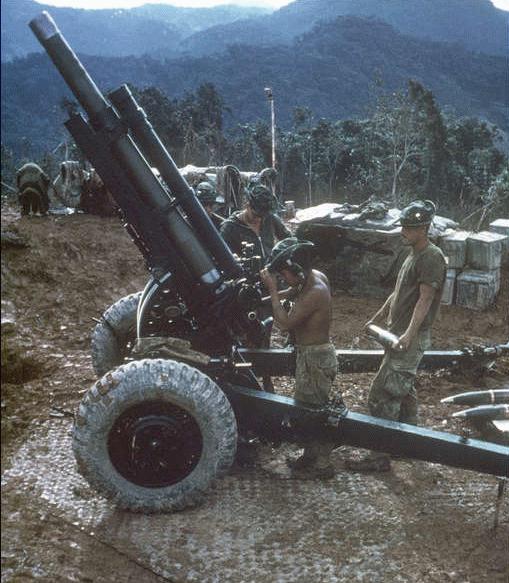Since the 105mm round comes as one assembly in the cardboard packing tube (which come two rounds to the box if I remember correctly), they are already together, and as I said the round is not crimped by the casing. It's very easy to lift off the round, grab the excess charges not called for and take them out of the brass shell casing. As Gino said, they are all connected by a thread in the 105mm and they are stacked with the highest number on the top. Good practice would be to leave all the charges in until you get a fire mission, and only when YOUR piece gets a specific fire command should any rounds be prepared for firing.
At that point, you remove the projectile, pull out the extra charge (or whatever) for only the number of rounds the fire command to your gun is. The easiest way is to place the projectile back into the casing with the extra bags dangling out and then give a quick "pull" and the casing edge will cut the string separating the excess charges.
As GIno said, if you HAVE to, it's very easy to take the projectile back off and put the bags back in loose, it absolutely makes no difference if they have been taken out.....unless they get wet!!! (The string serves no REAL function other than to keep all the bags together before you prepare the round, and is combusted with the bags and powder when you fire anyway). But good technique is to only prepare the rounds that were specifically called for on your piece with a fire command.
The biggest difference in a diorama depicting a 105mm, is that you WOULD have a lot of the empty brass shell cases lying around while you were firing. I'm not so sure that .22s would work, as that comes out to be a scale equivalent of 195mm, so they'd be too big around I think.
Separate loading ammo (155mm) is different in that the bags have a set of cloth "straps" which keep the whole thing together when you take the powder out of the powder canister. I think that either AFV or Verlinden has an example of that type of powder charges.
Those individual bags are usually larger than a soft ball, and again each bag is numbered individually. BUT separate loading powder DOES have a red "igniter pad" (faster burning than the regular powder) on the "bottom". Since that's what you want the "primer" to ignite first, and it thus should be at the back end of the breech, our #1 cannoneers were trained to always call out, "I see red", before he closed the breech to make sure the power was in correctly. Probably not unsafe, but for sure would affect accuracy.
In my units the powder was absolutely kept inside the canister until a fire command was sent, and only then taken out and the excess bags removed.
I'd have to go back and look at my Firing Table books to get a better answer, but on a 155mm, firing the tube at the exact same elevation, but changing the charge by one bag will make a significant difference in the distance the projo travels.
One trivial tidbit is that one thing that you should NEVER do in the middle of any single Fire Mission is to change the charge. You can imagine why! The FDC's job is to determine which charge is the best for the range to the target and order that for the duration of that mission.
Lower charges result in lower muzzle velocity (less power) and therefore require a greater "elevation" to reach the same distance (if it even can). And that also means a (slightly) longer time of flight AND a slightly easier task for the enemy to figure out where the rounds came from. So you want to pick a charge where the range to the target is about in the middle (or slightly less than) the limits for the charge.
The other thing with separate loading ammo, is that it was common to have not only a mixture of "white bag" and "green bag" powder, but you'd also often have different "lots" of either type. The variation within a lot is essentially zero, but from one lot to the next could be a consistent 30 -40 meters. If you had the time, you'd do special missions to figure out these differences and you could correct for that. For any GIVEN mission it wouldn't make any difference WHICH powder lot you specified, but you always had specify WHICH one you wanted to shoot, not SWITCH during the mission, and to keep track of exactly how much of each lot was on each gun.
God, I sure did love being an FDO!!!!
Tom














 (++)
(++) 































































